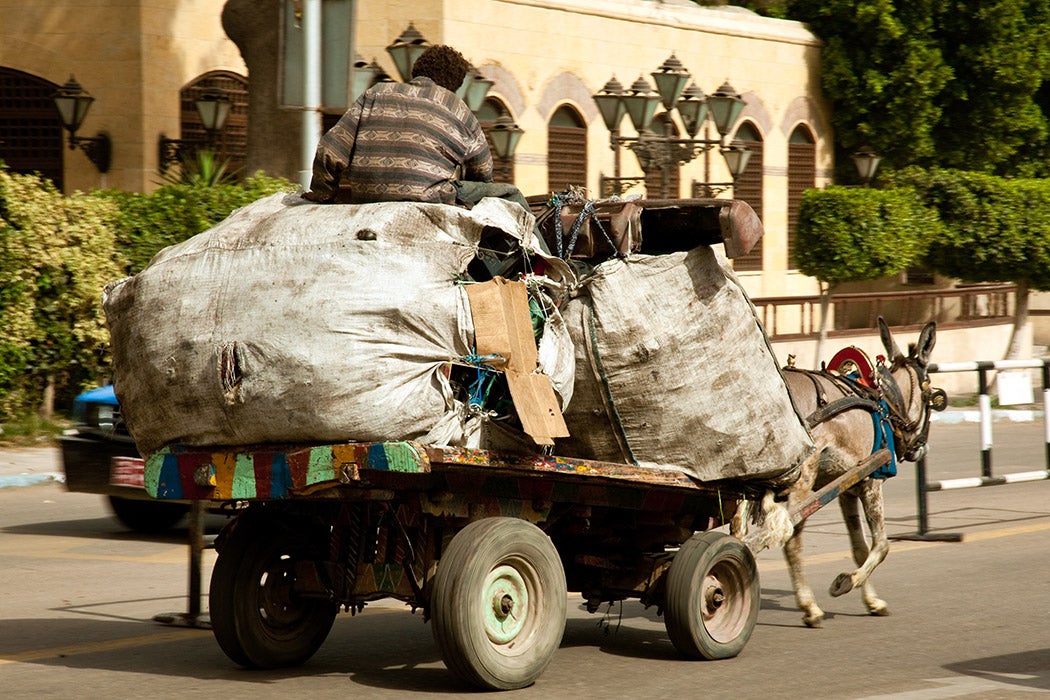Before the advent of municipal waste management, a subset of the desperately poor eked out a living by gathering, sorting, and reselling scraps. Through the nineteenth century, in cities including London and Paris, these ragpickers roamed the streets, collecting and sorting refuse as they went.
Ragpickers constituted an unofficial, self-employed recycling corps. They search mainly for cloth rags, as the papermaking industry was in constant need of them. But glass bottles and metal scraps were valuable, too, as they could be melted down and reused indefinitely. Even dog dung could be sold to tanneries for treating leather.
In Paris, ragpickers were identifiable by their hooks, with which they picked through trash; the baskets in which they carried their scraps; and the lanterns they used to make their way through the darkened streets—for, by law, they were only allowed to work at night. They lived in makeshift neighborhoods on the outskirts of Paris, many sleeping simply on piles of straw that they had gathered from the streets.
And yet, some found ways to make their humble homes beautiful. Historian Alain Faure notes that one contemporary observer recounts rooms decorated with mosaics of shattered mirrors, taxidermy birds, and carefully arranged stones. Another found that the doors and walls of the ragpickers’ homes were covered in alphabets and scribbled mathematical formulae, because the children of the group, whenever they could attend school, immediately brought back whatever they learned to share with the group.
This practice reflects a communal spirit that seems to have been a defining feature of ragpicker life. As Faure writes,
The collective lifestyle characterized the ragpicker communities.… Mutual aid was an accepted practice: “When he grows aged an infirm, a ragpicker does not go to the hospital. His neighbors will not allow him to suffer. Rather, they help him and take up collections to satisfy his needs, enduring deprivation to offer him small comforts.” The willingness of the ragmen to take in stray children…reflected both an interest in additional hands for gathering and a common practice of living and working together, as well as a form of public assistance for children.
While the advent of municipal trash services ended wide-scale ragpicking in Paris, it remains a global phenomenon among the very poor. Making a living from other’s scraps is the kind of forced ingenuity that can occur anywhere when people have little other choice. Today’s ragpickers deal more in PET plastic than linen scraps, but some of the same themes cut across continents and centuries: communities forced to survive outside of formal settlements, subjected to dangerous working conditions and extreme poverty, yet at the same time characterized by mutual aid, creativity, and solidarity. In 1960s Tokyo, for instance, a ragpicker’s collective known as the “Ants’ Villa” managed to develop from a squatter’s community in a public park into a neighborhood with its own apartment buildings, workshops, children’s center, and community restaurant.
One of the more famous modern ragpicking communities is formed by Cairo’s Zabbaleen. For decades, members of this Coptic population went door to door throughout the city, collecting trash and recycling up to 80 percent of what they gathered. They achieved this with the help of their pigs, who sorted through the waste with their snouts, eating the organic scraps and leaving behind the other potential recyclables for further processing.
Nicholas S. Hopkins and Sohair R. Mehanna write that the relationship between the Zabbaleen and their clients could be “somewhat contentious,” with the Zabbaleen collectors “resenting the effort it takes to collect the fee and residents resenting the unreliability of the collectors.” Hopkins and Mehanna note that the relationship could be even more fragile in the more impoverished sectors of the city, where the poor collected trash from the poor. There was “a problem of human organization here that few in these poor urban neighborhoods seem to be able to resolve on their own,” they write.
Partly as an attempt to address some of the existing system’s shortcomings, Cairo chose to outsource its trash collection to a number of multinational corporations in 2003. But the transition was easier said than done: the city’s narrow streets made it difficult for the companies’ garbage trucks to reach the majority of the residential neighborhoods, and the bins began to overflow. Meanwhile, Cairenes found themselves paying twice for trash pickup—once on their utility bill, and once to the Zabbaleen, who actually carried the trash away.
Weekly Newsletter
An even greater blow came in 2009, with the H1N1 outbreak. Panic over “swine flu” led the Egyptian government to order the culling of the Zabbaleen’s livestock, the most essential aspect of their recycling program. This destroyed their integrated system of waste management, in addition to decimating their income and removing an essential component of their diet.
Yet the Zabbaleen continue to make a living sorting and selling recyclables to this day. In the wake of the failures of the municipal systems introduced after 2003, the government began formalizing the Zabbaleen’s contributions to the city, providing them with uniforms and vehicles. The Zabbaleen have also entered the global market, teaming with an Egyptian NGO to sell goods made of recycled products to Europe and North America. If you’re wearing polyester right now, it’s possible that some part of your outfit was once a plastic bottle on the streets of Cairo, collected by hand and shredded into confetti for sale to the Chinese textile industry, so that what was once trash could re-enter the stream of human use, becoming something new.
Support JSTOR Daily! Join our new membership program on Patreon today.







